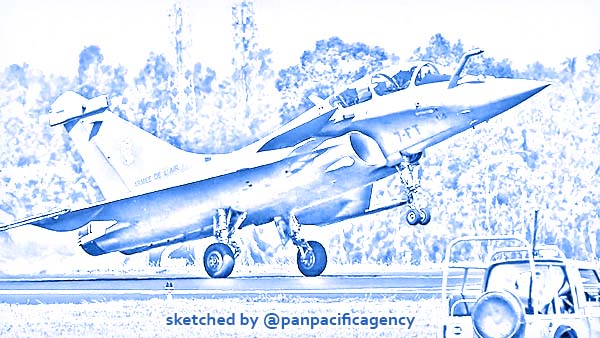6 Indian Air Force Rafales to arrive on July 27, squadron to be combat ready by August

French aircraft Rafale lands during the inauguration of the 12th edition of AERO India 2019 air show at Yelahanka airbase in Bengaluru on February 20. (AP Photo). Sketched by the Pan Pacific Agency.
NEW DELHI, Jun 29, 2020, India Today. The first batch of Rafale fighter jets is arriving in Ambala city of Haryana from Istres in France on July 27. Four-six Rafale jets are set to arrive in India, according to the initial inputs. The “Golden Arrows” squadron of the Rafale jets will be combat-ready by August, India Today reported.
While the delivery of “gamechanger” weapons like the Meteor and Scalp missiles, to India have already begun, about four-six Rafale jets will be delivered to India on July 27.
The Rafale jets are being ferried to Ambala in Haryana by the Indian pilots from Istres commune in southern France, with one stop at Al Dhafra Air Base in the UAE.
While only four-six Rafales are being delivered this year, all the 36 fighter jets will be delivered by 2022. India has purchased 36 Rafale jets from France at a cost of Rs 59,000 crore and the fighter jets.
They Rafales will be divided between two squadrons. While the first squadron of Rafale jets will be operational from Ambala in the western sector, the other one will come up in Hasimara in West Bengal.
The development amid India being engaged in a standoff with China for almost two months, which turned violent on June 15.
Twenty Indian Army personnel, including a commanding officer (CO), were killed in a fierce clash with Chinese troops in the Galwan Valley in eastern Ladakh on June 15.
Earlier, Defence Minister Rajnath Singh had said that the delivery of the Rafales will not be delayed despite challenges posed by the coronavirus pandemic.
“We discussed matters of mutual concern including Covid-19 situation, regional security and agreed to strengthen Bilateral Defence Cooperation between India and France,” Rajnath Singh said in a tweet.